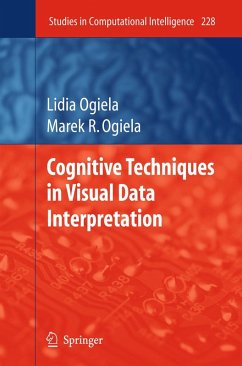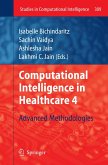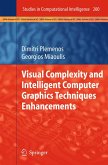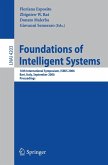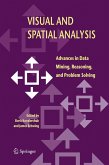The following chapters of this book presents key issues concerning the neurophysiological aspects of executing cognitive thought processes and the basics of cognitive informatics and new proposals of UBIAS systems dedicated to the meaning-based analysis of selected types of medical images. In particular, to structure the considerations of pattern classification methods, Chapter 2 discusses traditional image recognition techniques and algorithms from the simplest methods based on metric spaces up to methods that use the paradigms of computer image understanding. Chapter 3 deals with the cognitive aspects of brain function. Information from this chapter allows the authors, in a latter part of this book, to show functional analogies between the operation of biological systems and computer implementations. Chapter 4 provides a short compendium of knowledge about the new branch of informatics which formally describes thought processes, namely cognitive informatics. The introduction to subjects of cognitive processes analysed by cognitive informatics will then allow us to introduce new classes of computer systems executing cognitive resonance processes. The following Chapter 5 defines a new class of information systems using cognitive resonance processes. This chapter reviews several proposals of various classes of cognitive categorisation systems put forward by the authors. Chapter 6 contains a broader discussion of the UBIAS system class which the authors proposed for the meaning-based analysis of medical images. Then, Chapter 7 discusses in detail two examples of UBIAS systems built for the semantic classification of foot bone X-rays and images of long bone injuries in extremities. Chapter 8, the last, compiles and summarises information on creating cognitive vision systems designed for the semantic classification of patterns.
The authors present this book to Readers in the hope that it will stir their fascination with the scientific aspects of creating newgeneration computer systems which imitate thought processes and can determine the meaning of complex image patterns.
The following chapters of this book presents key issues concerning the neurophysiological aspects of executing cognitive thought processes and the basics of cognitive informatics and new proposals of UBIAS systems dedicated to the meaning-based analysis of selected types of medical images. In particular, to structure the considerations of pattern classification methods, Chapter 2 discusses traditional image recognition techniques and algorithms from the simplest methods based on metric spaces up to methods that use the paradigms of computer image understanding. Chapter 3 deals with the cognitive aspects of brain function. Information from this chapter allows the authors, in a latter part of this book, to show functional analogies between the operation of biological systems and computer implementations. Chapter 4 provides a short compendium of knowledge about the new branch of informatics which formally describes thought processes, namely cognitive informatics. The introduction to subjects of cognitive processes analysed by cognitive informatics will then allow us to introduce new classes of computer systems executing cognitive resonance processes. The following Chapter 5 defines a new class of information systems using cognitive resonance processes. This chapter reviews several proposals of various classes of cognitive categorisation systems put forward by the authors. Chapter 6 contains a broader discussion of the UBIAS system class which the authors proposed for the meaning-based analysis of medical images. Then, Chapter 7 discusses in detail two examples of UBIAS systems built for the semantic classification of foot bone X-rays and images of long bone injuries in extremities. Chapter 8, the last, compiles and summarises information on creating cognitive vision systems designed for the semantic classification of patterns.
The authorspresent this book to Readers in the hope that it will stir their fascination with the scientific aspects of creating new generation computer systems which imitate thought processes and can determine the meaning of complex image patterns.
The following chapters of this book presents key issues concerning the neurophysiological aspects of executing cognitive thought processes and the basics of cognitive informatics and new proposals of UBIAS systems dedicated to the meaning-based analysis of selected types of medical images. In particular, to structure the considerations of pattern classification methods, Chapter 2 discusses traditional image recognition techniques and algorithms from the simplest methods based on metric spaces up to methods that use the paradigms of computer image understanding. Chapter 3 deals with the cognitive aspects of brain function. Information from this chapter allows the authors, in a latter part of this book, to show functional analogies between the operation of biological systems and computer implementations. Chapter 4 provides a short compendium of knowledge about the new branch of informatics which formally describes thought processes, namely cognitive informatics. The introduction to subjects of cognitive processes analysed by cognitive informatics will then allow us to introduce new classes of computer systems executing cognitive resonance processes. The following Chapter 5 defines a new class of information systems using cognitive resonance processes. This chapter reviews several proposals of various classes of cognitive categorisation systems put forward by the authors. Chapter 6 contains a broader discussion of the UBIAS system class which the authors proposed for the meaning-based analysis of medical images. Then, Chapter 7 discusses in detail two examples of UBIAS systems built for the semantic classification of foot bone X-rays and images of long bone injuries in extremities. Chapter 8, the last, compiles and summarisesinformation on creating cognitive vision systems designed for the semantic classification of patterns.
The authors present this book to Readers in the hope that it will stir their fascination with the scientific aspects of creating new generation computer systems which imitate thought processes and can determine the meaning of complex image patterns.
The authors present this book to Readers in the hope that it will stir their fascination with the scientific aspects of creating newgeneration computer systems which imitate thought processes and can determine the meaning of complex image patterns.
The following chapters of this book presents key issues concerning the neurophysiological aspects of executing cognitive thought processes and the basics of cognitive informatics and new proposals of UBIAS systems dedicated to the meaning-based analysis of selected types of medical images. In particular, to structure the considerations of pattern classification methods, Chapter 2 discusses traditional image recognition techniques and algorithms from the simplest methods based on metric spaces up to methods that use the paradigms of computer image understanding. Chapter 3 deals with the cognitive aspects of brain function. Information from this chapter allows the authors, in a latter part of this book, to show functional analogies between the operation of biological systems and computer implementations. Chapter 4 provides a short compendium of knowledge about the new branch of informatics which formally describes thought processes, namely cognitive informatics. The introduction to subjects of cognitive processes analysed by cognitive informatics will then allow us to introduce new classes of computer systems executing cognitive resonance processes. The following Chapter 5 defines a new class of information systems using cognitive resonance processes. This chapter reviews several proposals of various classes of cognitive categorisation systems put forward by the authors. Chapter 6 contains a broader discussion of the UBIAS system class which the authors proposed for the meaning-based analysis of medical images. Then, Chapter 7 discusses in detail two examples of UBIAS systems built for the semantic classification of foot bone X-rays and images of long bone injuries in extremities. Chapter 8, the last, compiles and summarises information on creating cognitive vision systems designed for the semantic classification of patterns.
The authorspresent this book to Readers in the hope that it will stir their fascination with the scientific aspects of creating new generation computer systems which imitate thought processes and can determine the meaning of complex image patterns.
The following chapters of this book presents key issues concerning the neurophysiological aspects of executing cognitive thought processes and the basics of cognitive informatics and new proposals of UBIAS systems dedicated to the meaning-based analysis of selected types of medical images. In particular, to structure the considerations of pattern classification methods, Chapter 2 discusses traditional image recognition techniques and algorithms from the simplest methods based on metric spaces up to methods that use the paradigms of computer image understanding. Chapter 3 deals with the cognitive aspects of brain function. Information from this chapter allows the authors, in a latter part of this book, to show functional analogies between the operation of biological systems and computer implementations. Chapter 4 provides a short compendium of knowledge about the new branch of informatics which formally describes thought processes, namely cognitive informatics. The introduction to subjects of cognitive processes analysed by cognitive informatics will then allow us to introduce new classes of computer systems executing cognitive resonance processes. The following Chapter 5 defines a new class of information systems using cognitive resonance processes. This chapter reviews several proposals of various classes of cognitive categorisation systems put forward by the authors. Chapter 6 contains a broader discussion of the UBIAS system class which the authors proposed for the meaning-based analysis of medical images. Then, Chapter 7 discusses in detail two examples of UBIAS systems built for the semantic classification of foot bone X-rays and images of long bone injuries in extremities. Chapter 8, the last, compiles and summarisesinformation on creating cognitive vision systems designed for the semantic classification of patterns.
The authors present this book to Readers in the hope that it will stir their fascination with the scientific aspects of creating new generation computer systems which imitate thought processes and can determine the meaning of complex image patterns.
Dieser Download kann aus rechtlichen Gründen nur mit Rechnungsadresse in A, B, BG, CY, CZ, D, DK, EW, E, FIN, F, GR, HR, H, IRL, I, LT, L, LR, M, NL, PL, P, R, S, SLO, SK ausgeliefert werden.

